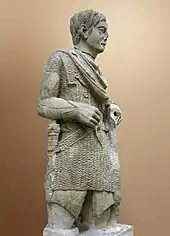Roman Gaul
Roman Gaul refers to Gaul[1] under provincial rule in the Roman Empire from the 1st century BC to the 5th century AD.
Part of a series on the |
|---|
| History of France |
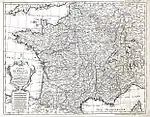 |
| Timeline |
|
|
History
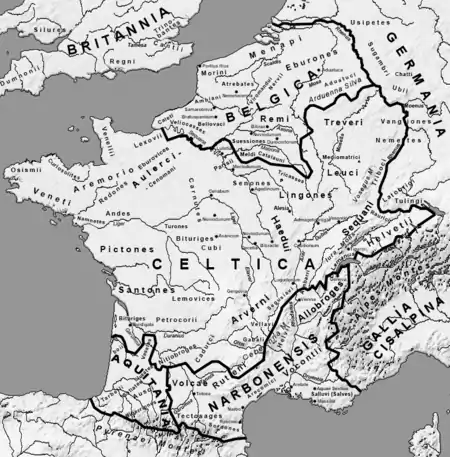
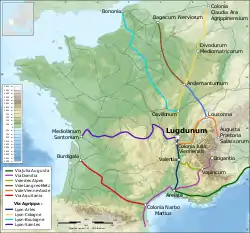

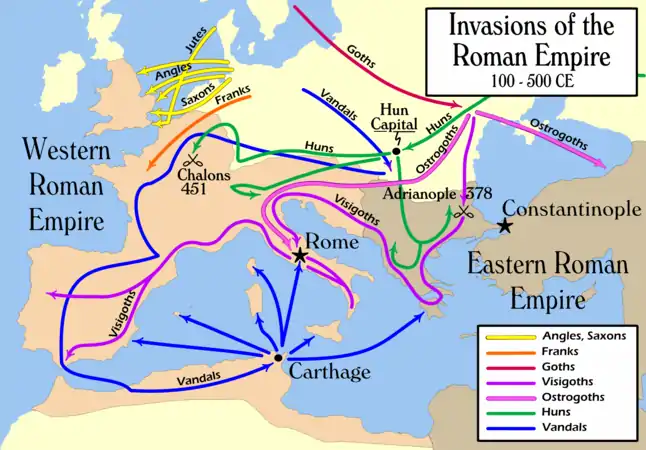
The Roman Republic's influence began in southern Gaul. By the mid-2nd century BC, Rome was trading heavily with the Greek colony of Massilia (modern Marseille) and entered into an alliance with them, by which it agreed to protect the town from local Gauls, including the nearby Aquitani and from sea-borne Carthaginians and other rivals, in exchange for land that it wanted in order to build a road to Hispania, to assist in troop movements to its provinces there. The Mediterranean settlements on the coast continued to be threatened by the powerful Gallic tribes to the north and in 122 BC the Roman general Gnaeus Domitius Ahenobarbus campaigned in the area and defeated the Allobroges followed by Quintus Fabius Maximus against the Arverni under King Bituitus in 121 BC.[2]
The area became a Roman province in 121 BC[3] originally under the name Gallia Transalpina (Transalpine Gaul). The name distinguished it from Cisalpine Gaul on the near side of the Alps to Rome.
In this new province the Romans founded the town of Narbonne in 118 BC. At the same time they built the Via Domitia, the first Roman road in Gaul, connecting Italy to Hispania. They also built the Via Aquitania, which led toward the Atlantic through Tolosa (Toulouse) and Burdigala (Bordeaux). Thus the Romans built a crossroads that made Narbonne an optimal trading centre, and a major trading competitor to Massilia.
It was from Narbonne that Julius Caesar significantly advanced the task by defeating the Celtic tribes in the Gallic Wars of 58-51 BC.[4] Massilia fell in the Siege of Massilia.
Massilia was allied to Pompey in Caesar's civil war which led to its eventual defeat at the Siege of Massilia in 49 BC after which it lost its territories but was allowed to keep nominal autonomy, due to ancient ties of friendship and support of Rome.
In 40 BC, during the Second Triumvirate, Lepidus was given responsibility for Gallia Narbonensis (along with Hispania and Africa), while Mark Antony was given the balance of Gaul.[5]
In 22 BC, imperial administration of Gaul was reorganised establishing the provinces of Gallia Aquitania, Gallia Belgica and Gallia Lugdunensis. Parts of eastern Gaul were incorporated into the provinces Raetia (15 BC) and Germania Superior (AD 83).
Citizenship was granted to all in 212 by the Constitutio Antoniniana.
Generals Marcus Antonius Primus and Gnaeus Julius Agricola were both born in Gaul, as were emperors Claudius and Caracalla. Emperor Antoninus Pius also came from a Gaulish family.
In the Crisis of the Third Century around 260, Postumus established a short-lived Gallic Empire, which included the Iberian Peninsula and Britannia, in addition to Gaul itself. Germanic tribes, the Franks and the Alamanni, invaded Gaul at this time. The Gallic Empire ended with Emperor Aurelian's victory at Châlons in 274.
In 286/7 Carausius commander of the Classis Britannica, the fleet of the English Channel, declared himself Emperor of Britain and northern Gaul.[6] His forces comprised his fleet, the three legions stationed in Britain and also a legion he had seized in Gaul, a number of foreign auxiliary units, a levy of Gaulish merchant ships, and barbarian mercenaries attracted by the prospect of booty.[7] In 293 emperor Constantius Chlorus isolated Carausius by besieging the port of Gesoriacum (Boulogne-sur-Mer) and invaded Batavia in the Rhine delta, held by his Frankish allies, and reclaimed Gaul.
A migration of Celts from Britain appeared in the 4th century in Armorica led by the legendary king Conan Meriadoc. They spoke the now extinct British language, which evolved into the Breton, Cornish, and Welsh languages.
The Goths who had sacked Rome in 410 established a capital in Toulouse and in 418 succeeded in being accepted by Honorius as foederati and rulers of the Aquitanian province in exchange for their support against the Vandals.[8]
The Roman Empire had difficulty responding to all the barbarian raids, and Flavius Aëtius had to use these tribes against each other in order to maintain some Roman control. He first used the Huns against the Burgundians, and these mercenaries destroyed Worms, killed king Gunther, and pushed the Burgundians westward. The Burgundians were resettled by Aëtius near Lugdunum in 443. The Huns, united by Attila, became a greater threat, and Aëtius used the Visigoths against the Huns. The conflict climaxed in 451 at the Battle of Châlons, in which the Romans and Goths defeated Attila.
After the fall of Rome
The Roman administration finally collapsed as remaining Roman troops withdrew southeast to protect Italy. Between 455 and 476 the Visigoths, the Burgundians, and the Franks assumed control in Gaul. However, certain aspects of the ancient Celtic culture continued after the fall of Roman administration and the Domain of Soissons, a remnant of the Empire, survived from 457 to 486.
In 486 the Franks defeated the last Roman authority in Gaul at the Battle of Soissons. Almost immediately afterwards, most of Gaul came under the rule of the Merovingians, the first kings of a proto-France.
In 507, the Visigoths were pushed out of most of Gaul by the Frankish king Clovis I at the Battle of Vouillé.[9] They were able to retain Narbonensis and Provence after the timely arrival of an Ostrogoth detachment sent by Theodoric the Great.
Certain Gallo-Roman aristocratic families continued to exert power in episcopal cities (such as the Mauronitus family in Marseilles and Bishop Gregory of Tours). The appearance of Germanic given and family names becomes noticeable in Gallia/Francia from the middle of the 7th century on, most notably in powerful families, indicating that the centre of gravity had definitely shifted.
The Gallo-Roman (or Vulgar Latin) dialect of the late Roman period evolved into the dialects of the Oïl languages and Old French in the north, and into Occitan in the south.
The name Gallia and its equivalents continued in use, at least in writing, until the end of the Merovingian period in the 750s. Slowly, during the ensuing Carolingian period (751-987), the expression Francia, then Francia occidentalis spread to describe the political reality of the kingdom of the Franks (regnum francorum).
Geographical divisions

Before 22 BC Gaul had three geographical divisions, one of which was divided into multiple Roman provinces:
- Gallia Cisalpina or "Gaul this side of the Alps", covered most of present-day northern Italy. It was conquered by the Romans around 121 BC, but was not made a formal province until 81 BC. By the end of the republic, it was annexed into Italy itself.
- Gallia Transalpina, or "Gaul across the Alps", was originally conquered and annexed in 121 BC in an attempt to solidify communications between Rome and the Iberian peninsula. It comprised most of what is now southern France, along the Mediterranean coast from the Pyrenees to the Alps. It was later renamed Gallia Narbonensis, after its capital city, Narbo.
- Gallia Comata, "free Gaul" or "long haired Gaul", encompassed the remainder of present-day France, Belgium, and westernmost Germany, including Aquitania, Gallia Celtica and Belgica. It had tributary status throughout the second and first centuries BC, but was still formally independent of Rome. It was annexed into the Empire as a result of Julius Caesar's victory in the Gallic Wars in 50 BC.
After 22 BC the Romans divided Gallia Comata into three provinces, the Tres Galliae (the 3 Gauls):
- Gallia Aquitania, corresponding to central and western France;
- Gallia Belgica, corresponding to northeastern France, Belgium, Luxembourg, and western Germany; capital at Reims, later Trier
- Gallia Lugdunensis, corresponding to eastern and northern France; capital at Lugdunum (Lyon)
The Romans divided these huge provinces into civitates corresponding more or less with the pre-Conquest communities or polities sometimes described misleadingly as "tribes," such as the Aedui, Allobroges, Bellovaci, and Sequani (see List of Celtic tribes) but the civitates were too large and in turn were divided into smaller units, pagi, a term that eventually became the modern French word "pays".[10] These administrative groupings would be taken over by the Romans in their system of local control, and these civitates would also be the basis of France's eventual division into ecclesiastical bishoprics and dioceses, which would remain in place—with slight changes—until the French revolution.
Language and culture
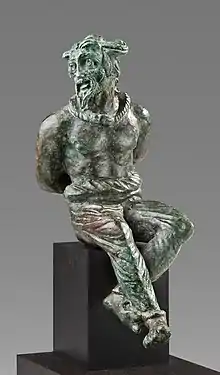
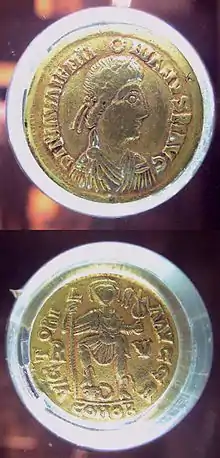
In the five centuries between Caesar's conquest and the collapse of the Western Roman Empire, the Gaulish language and cultural identity underwent a syncretism with the Roman culture of the new governing class, and evolved into a hybrid Gallo-Roman culture that eventually permeated all levels of society. Gauls continued writing some inscriptions in the Gaulish language, but switched from the Greek alphabet to the Latin alphabet during the Roman period. Current historical research suggests that Roman Gaul was "Roman" only in certain (albeit major) social contexts, the prominence of which in material culture has hindered a better historical understanding of the permanence of many Celtic elements. The Roman influence was most apparent in the areas of civic religion and administration. The Druidic religion was suppressed by Emperor Claudius I, and in later centuries Christianity was introduced. The prohibition of Druids and the syncretic nature of the Roman religion led to disappearance of the Celtic religion. It remains to this day poorly understood: current knowledge of the Celtic religion is based on archeology and via literary sources from several isolated areas such as Ireland and Wales.
The Romans easily imposed their administrative, economic, artistic (especially in terms of monumental art and architecture) and literary culture. They wore the Roman tunic instead of their traditional clothing.
Surviving Celtic influences also infiltrated back into the Roman Imperial culture in the 3rd century. For example, the Gaulish tunic—which gave Emperor Caracalla his surname—had not been replaced by Roman fashion. Similarly, certain Gaulish artisan techniques, such as the barrel (more durable than the Roman amphora) and chain mail were adopted by the Romans.
The Celtic heritage also continued in the spoken language (see History of French). Gaulish spelling and pronunciation of Latin are apparent in several 5th century poets and transcribers of popular farces.[12] The last pockets of Gaulish speakers appear to have lingered until the 6th or 7th century. Gaulish was held to be attested by a quote from Gregory of Tours written in the second half of the 6th century,[13] which describes how a shrine "called 'Vasso Galatae' in the Gallic tongue" was destroyed and burnt to the ground.[14] Throughout the Roman rule over Gaul, although considerable Romanization in terms of material culture occurred, the Gaulish language is held to have survived and continued to be spoken, coexisting with Latin.[13]
Germanic placenames were first attested in border areas settled by Germanic colonizers (with Roman approval). In the 4th and 5th centuries, the Franks settled in northern France and Belgium, the Alemanni in Alsace and Switzerland, and the Burgundians in Savoie.
See also
- Asterix, French comic set in 50 BC Gaul
- Roman Britain's continental trade
Notes
- The territory of Gaul roughly corresponds to modern-day France, Belgium and Luxembourg, and adjacient parts of the Netherlands, Switzerland and Germany.
- Drinkwater, John (2014). Roman Gaul (Routledge Revivals): The Three Provinces, 58 BC-AD 260. Routledge. ISBN 978-1317750741 p.6
- Maddison, Angus (2007), Contours of the World Economy 1–2030 AD: Essays in Macro-Economic History, Oxford: Oxford University Press, p. 41, ISBN 9780191647581
- Julius Caesar: Commentarii de Bello Gallico
- Boatwright et al., The Romans, From Village to Empire, p.272 ISBN 978-0-19-511876-6
- Panegyrici Latini, 8:6; Aurelius Victor, Book of Caesars 39:20-21; Eutropius, Abridgement of Roman History 21; Orosius, Seven Books of History Against the Pagans 7:25.2-4
- Panegyrici Latini 8:12
- O'Callaghan, Joseph. "Spain: The Visigothic Kingdom". Encyclopædia Britannica Online. Retrieved 17 September 2019.
- Bennett, Matthew (2004). "Goths". In Holmes, Richard; Singleton, Charles; Jones, Spencer (eds.). The Oxford Companion to Military History. Oxford University Press. p. 367. ISBN 9780191727467
- Patrick Galliou and Michael Jones, The Bretons, 1991, p. 79.
- Ashton, Kasey. "The Celts Themselves." University of North Carolina. Accessed 5 November 2017.
- Histoire de France, ed. Les Belles lettres, Paris.
- Laurence Hélix. Histoire de la langue française. Ellipses Edition Marketing S.A. p. 7. ISBN 978-2-7298-6470-5.
Le déclin du Gaulois et sa disparition ne s'expliquent pas seulement par des pratiques culturelles spécifiques: Lorsque les Romains conduits par César envahirent la Gaule, au 1er siecle avant J.-C., celle-ci romanisa de manière progressive et profonde. Pendant près de 500 ans, la fameuse période gallo-romaine, le gaulois et le latin parlé coexistèrent; au VIe siècle encore; le temoignage de Grégoire de Tours atteste la survivance de la langue gauloise.
- Hist. Franc., book I, 32 Veniens vero Arvernos, delubrum illud, quod Gallica lingua Vasso Galatæ vocant, incendit, diruit, atque subvertit. And coming to Clermont [to the Arverni] he set on fire, overthrew and destroyed that shrine which they call Vasso Galatæ in the Gallic tongue.
References
- Portions of this article are based on a translation of the article Gaule from the French Wikipedia on February 2007.
External links
| Wikimedia Commons has media related to Roman Gaul. |
- Romans in Gaul : A Webliography - A Teacher Workshop held at Temple University, November 3, 2001. Dr. Janice Siegel, Department of Classics, Hampden-Sydney College, Virginia
